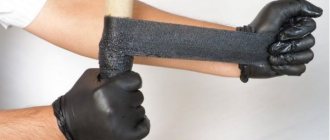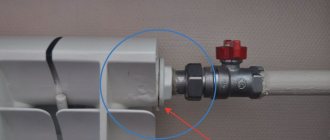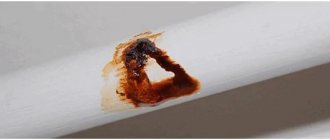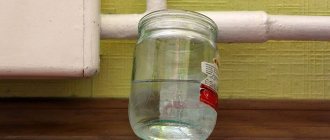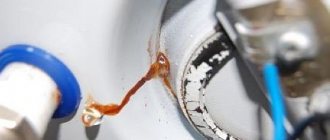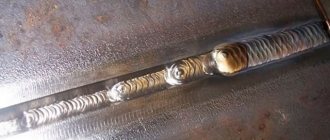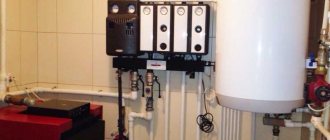Sooner or later everything goes wrong. But when the heating battery leaks, many people don’t know what to do. But almost everyone has to face this problem.
In order to avoid damage to your own and your neighbors’ property, you must adhere to a certain procedure. In addition, during the heating season, hot water flows in the radiators, which can burn you. Therefore, everyone should know what to do if the heating battery is leaking.
The heating battery is leaking - what to do?
The first thing to do if the radiator is leaking, as in the photo, is to turn off the water. But if the leak is serious, then it is urgent to call an emergency team - plumbers have all the necessary tools and materials to eliminate the problem if the battery leaks.
If boiling water is pouring out of the radiator in all directions, then you need to throw something thick over it - for example, a blanket. This is not a way to get rid of a leak, but at least you will be able to approach it without fear of injury.
Next, if possible, you need to turn off the water. It’s good if there is a tap or valve in the apartment itself - this will allow you to quickly turn off the water supply and save your property. But what if there is no such valve and the radiator is leaking - what to do? Then you need to turn on the coolant supply valve to the heating system, which is located on the main pipe near its entrance to the basement. If the leak is minor, then you can try to fix it yourself (for more details: “How to fix a leaking heating pipe if it is leaking”).
Which to choose
As already mentioned, devices for heating radiators are ball, adjustable and air venting. Each of them performs a specific function. For example, the ball-type version is used to repair a radiator. The adjustment option is installed in front of the radiator and is used to adjust the volume of coolant. But Mayevsky’s device must be present, since it is indispensable when releasing air.
It is quite enough if the heating system has 2 taps near the radiator: Mayevsky and regulating. The ball valve can be replaced with an adjustment valve.
You also need to choose a quality product. Based on the fact that the structure is always in contact with water, you need to choose a brass option. But some manufacturers offer a fake, in which a different alloy is used instead of brass. These should be abandoned immediately.
How to fix a leak
There are several options for solving the problem, using:
- self-tapping bolt;
- rubber pad with wire or clamp;
- cement-plaster bandage;
- fabric impregnated with heat- and water-resistant glue;
- special sealant;
- welding
The easiest way to fix a small leak in a cast iron radiator is to fix a self-tapping bolt in the hole.
It must be remembered that all these methods of eliminating leaks are only a temporary measure - it is advisable to replace old radiators with new products as soon as possible.
Necessary tools for work
To do the work yourself, you only need a few tools. All of them are available for free sale, and those who periodically do something with their own hands most often have this tool in stock:
- Adjustable plumbing wrench. It can be used to unscrew connections of different diameters.
- Medium size pliers.
- Flathead and Phillips screwdrivers.
- A set of hexagons (or one key to the size of the screw securing the lever).
- A flashlight if you need to look at something without taking it off.
It is also worth stocking up on rags to wipe away any spilled water and clean the elements from dirt. If you have to clean the inside of the faucet, an old toothbrush may come in handy.
Cement-plaster dressing to eliminate leakage of the heating radiator
Before fixing a leak in the heating battery, you need to prepare the required materials and tools:
- cement;
- alabaster (plaster);
- container with water;
- salt;
- medical bandage
To eliminate the leak, a bandage is applied to the damaged area.
The procedure after turning off the water is as follows:
- dilute cement in a container with water to the consistency of thick sour cream;
- cut the bandage into strips 25-30 centimeters long;
- thoroughly soak the bandage with the cement mixture;
- wrap strips around the damaged area.
The process is repeated until a durable bandage is obtained.
If it was not possible to turn off the water, then instead of cement you need to use alabaster, which dries much faster. Then a cement bandage is applied to the plaster cast.
If the heating battery leaks at the threaded connection, you can use salt:
- wet strips of cloth or bandage in water;
- roll the material thoroughly in salt;
- wrap the leak area.
The gap will close as a result of the salt dissolving in the water. A cement bandage is applied on top.
Installation - step by step instructions
The sequence of actions when installing the device is as follows:
- First you need to choose the place where the structure will be installed. Air vents must be installed in the battery plug.
- Then the threads of the device must be wrapped with sealing tape. FUM tape is considered the best.
- Then you need to screw the device into the place where the couplings were previously located.
- Now you need to check that there are no leaks at the connection point.
Thus, installing a crane is not a difficult process, so one person can easily handle it on their own.
A centralized or individual heating system needs adjustment. The weather has a pleasant property of changing, but the temperature of the coolant in the system most often remains unchanged. As a result, a sad picture is observed: there is frost outside the window, and tropical heat in the rooms. Owners of private houses with individual heating can fully control the air temperature in each room thanks to modern automation systems.
But there is also a less expensive way to regulate the intensity of coolant flow - installing taps on radiators. The presence of these simple but useful devices also allows for more efficient repair and maintenance of radiators, since with the help of such taps you can disconnect the radiator from the system at any time, and then just as easily connect it again.
Using a clamp and rubber as a means to eliminate radiator leaks
If you cannot find a special remedy for eliminating radiator leaks, then you can simply cut pieces of rubber from a bicycle inner tube - the strips should be 30-35 centimeters long and 4-5 centimeters wide. Using a clamp, you can stop the leak for a while. For this reason, it doesn’t hurt to have a few clamps in stock at home - their price is low.
Methods for sealing connections
If the thread profile does not have a sharp edge, FUM tape can be used as a sealant. However, this modern material has not caught on among experienced specialists; they consider flax to be the most reliable sealant. A thin strand of this material, collected into a bundle, is wound around the pipe, starting from its end. The winding direction should be opposite to the thread direction. The flax should fill the thread to its full depth, and each new turn should partially overlap the previous one. The seal will be more reliable if the thread is equipped with a notch that prevents the flax winding from turning. Before installation, the threads of the part should be coated with UniPak packaging paste or similar.
Installation on polypropylene pipes using adapter couplings.
If the heating system is made of polypropylene pipes, then metal ball valves on the heating radiators are installed using adapter couplings. All threaded connections in this case are sealed according to the method described above.
Mayevsky taps are often equipped with a gasket made of rubber or other material, so they do not need to seal the FUM with tape or tow.
When the installation or replacement of all shut-off and control valves has been completed, it is necessary to perform a test run of the system. This will make it possible to check the tightness of all connections and the functioning of the valves under operating conditions. In this case, it is important to make sure that the system is completely de-aerated and the working medium circulates normally in it. A small amount of sealing material should be added to threaded connections that are found to be leaking.
Hermetic seal to eliminate leaks
Such a composition polymerizes upon contact with air, and as a result of hardening, a strong filling is formed, which gives time for significant repairs. Some sealants are two-component polymer compounds, and harden as a result of mixing their two components. Other products harden as a result of a chemical reaction with air. Using sealants designed specifically to fix leaks, you can solve the problem in a matter of minutes.
Expert advice
Here are some recommendations that will allow you not only to carry out the work quickly and efficiently, but also to choose a reliable mixer that will work for a long time. You need to remember the following:
- Before buying a mixer, you should read reviews from people on thematic resources. There you can find out which companies' products are reliable and which models are better not to purchase.
- You should not buy models from the most budget segment; most often they do not last long. You can also compare products by weight: the heavier it is, the better the quality of the metal used.
- It is best to purchase a set of seals along with the mixer, if ready-made sets are available. This will allow for quick repairs in most cases.
- Be sure to install a filter at the water supply inlet to the house. Even the simplest option of rough cleaning significantly extends the service life of the ball valve, since contaminants do not enter the system.
- It is best to conduct a preventive inspection and replace some components at the first sign of malfunction. For example, the faucet may begin to move much more tightly or, conversely, the lever will turn too freely. Also a sign of a problem are extraneous noises or difficulty setting the appropriate temperature if everything was fine before.
- To avoid scratching the nut when unscrewing with a spanner, it is worth placing a rag, this will protect the chrome coating.
- After turning off the inlet tap, drain the remaining water from the system. When disassembling, use a rag, as some liquid always spills.
Welding Application
If you have certain skills and a welding machine, you can simply weld the leak. This is the best way to solve the problem, but it is not suitable for all radiators - only for steel appliances.
If the battery is leaking, what should you do? The first thing you need to do is stop the water supply to the heating device. It’s good if the leak occurred in the summer, but much more often they happen during the heating season. Since you can simply scald yourself with hot water, you must first turn off the coolant supply.
In case of serious damage, it is necessary to call an emergency team - experienced plumbers will be able to quickly solve the problem. If the leak is small, then it can be eliminated using improvised means. But you need to remember that any method of eliminating a leak will only help temporarily restore the operation of the heating device, so it is recommended to change it in the near future.
One way to fix a battery leak is shown in the video:
As practice shows, most often the battery leaks as a result of regular hydraulic loads and after water discharges in the summer. The condition of the battery deteriorates greatly if it is in use for more than 10 years. To be prepared for leaks, it is better to familiarize yourself with methods for eliminating them in advance.
Due to prolonged use, any of the connections between pipes and batteries may lose their tightness. Depending on where the wear occurred, experts identify the following types of leaks:
- depressurization of the joint where the riser connects to the pipes;
- pipe damage;
- formation of cracks at the joints of battery sections;
- the appearance of a leak in one of the sections of the element.
Tips for preventing leaking heating valves
- In the warm season, repair or replace in advance all fittings that turn poorly, undermine, jam, spin, or have traces of corrosion.
- Inspect the joints where the taps connect with pipes and radiators, replace worn elements of the heating system.
- Do not use shut-off valves as control valves. It is intended only to shut off the water. Otherwise, the fluoroplastic gasket will wear out and a leak will occur.
Unfortunately, most operations to replace and repair such elements are difficult to perform independently. Therefore, there is no need to overestimate your strength and call a specialist at the slightest doubt.
Preparation and necessary tools
The first rule of any plumbing repair is to turn off the water supply. Valves can usually be found in the toilet; the levers simply need to be turned 90 degrees. If the equipment has not been used for a long time, the valves may become blocked. It doesn't take any heroic effort to turn them. This way, you can simply rip off the tap and then instead of one problem you will have to solve two. Valves should be developed carefully, gradually increasing the effort and adding lubricant drop by drop.
Only after the water supply is securely shut off can repair work begin. First you need to prepare the necessary tools so that they are at hand:
- adjustable wrench;
- flat screwdriver;
- crosshead screwdriver
- wrench, etc.
Usually this simple set is quite enough. Auxiliary elements will not interfere, for example, pieces of rubber or leather for making new gaskets, fluoroplastic sealing tape, which replaces liners, rags, sponges, detergent to remove dirt accumulated inside the mixer, etc.
Advice. To prevent an accidentally dropped tool from damaging the sink or bathtub, it doesn’t hurt to put something soft underneath: a rag, a piece of foam rubber or other material suitable as a shock absorber.
The reasons why a faucet is leaking can be very different. For a traditional two-valve faucet, the most pressing problem is the wear of the gasket or liner, which needs to be replaced. If a ball (or hinge) valve, which is designed fundamentally differently, is leaking, completely different actions will be needed.
A few words about the Mayevsky crane
In addition to conventional ball valves, there is a mechanism that is designed specifically for radiators - the Mayevsky valve. This device is necessary not to regulate the flow of coolant, but to remove air that somehow got into the flow. At the heart of the device is a needle mechanism specially designed for these purposes.
The Mayevsky tap is a small device that is usually installed at the highest point of the heating system to bleed air trapped in the pipes
There are two types of Mayevsky cranes - a simple mechanical model and an automatic device. The first is controlled manually, the second is adjusted accordingly and turns on when needed. Removing air from the heating system helps prevent the formation of air pockets and improve the efficiency of the system.
Mayevsky taps are installed at the highest point of the system where air accumulates. If the system operates with forced circulation, it is recommended to turn off the pump and wait a while before turning on such a tap.
When choosing a faucet for a cast iron battery, you should remember that in such structures a lot of contaminants accumulate, which create additional load on the faucet
Mayevsky's automatic tap is usually used only in autonomous heating systems. In this case, home owners can control the quality of the coolant, regularly clean the system, etc. In apartment buildings with centralized heating, manually operated Mayevsky tap models are used; they are more durable and better resistant to contamination, which is typical for coolant in public systems. In such conditions, automatic models become clogged and break very quickly. Those who have old cast iron radiators in their house should be especially attentive to the condition of the taps on the radiators.
Shut-off and control valves, which are often called taps in everyday life, are the most important part of any heating system. Errors when choosing or installing these devices very often are not limited to a deterioration in the performance of the heating system, but lead to emergency situations with very tangible consequences. Hot water gushing out with strong pressure from a burst or broken faucet will have time to cause considerable damage while the system is completely turned off, and in the worst case, it can result in burns and other injuries. Therefore, the selection, installation and operation of fittings should be approached very carefully. We'll talk about how to do all this correctly.
Repair of two-valve tap
Replacing the gasket
The answer to the question: why does the faucet leak, no matter how tightly it is screwed on, most likely sounds like this: the problem is a worn-out gasket. Replacing it is not difficult, to do this you need:
- Unscrew the valve body (simply rotate it counterclockwise).
- Remove damaged or worn gasket.
- Make a new gasket from a piece of thick leather or rubber. Of course, they take the old gasket as a sample.
- Install a new gasket.
- Wrap the seal around the stop edge.
- Reinstall the valve body by turning it clockwise.
- Using a wrench, tighten the installed valve tightly.
In order not to bother with making a gasket, you can buy a new one at a plumbing store. However, if for some reason this is not possible, a homemade part is quite suitable for urgent repair of the crane.
The diagram shows in detail how to properly replace the ceramic gasket in a traditional two-handle faucet. You will need a Phillips screwdriver and a wrench
Replacing the sealing insert of the oil seal
Wear of the oil seal insert can also cause a leak. In this case, a leak is observed when the tap is open: water enters between the gland nut and the valve stem. To correct the situation, you need to:
- Using a screwdriver, unscrew the oil seal nut.
- Make a sealing liner from recycled plastic sealing tape.
- Remove the worn liner.
- Wind the new insert tightly onto the valve stem.
- Tighten the nut.
If everything is done correctly, the valve will turn smoothly and the leak will stop.
Replacing the O-ring of a shower hose
When a leak occurs where the faucet and shower hose connect, the problem is usually caused by a worn O-ring. To replace it, you must:
- Using an adjustable wrench, unscrew the shower hose. This must be done carefully, otherwise you can easily damage the hose threads.
- Remove the worn seal.
- Install a new O-ring.
- Reinstall the shower hose.
If possible, it is best to use an O-ring made of silicone. Rubber parts are less resistant to wear and therefore are not as durable.
Most often, to eliminate a faucet leak, you have to replace the rubber gasket or part of the locking mechanism - the faucet. These parts can be purchased at a plumbing store.
When, when switching the water supply to the shower hose, a small amount of water continues to flow out of the tap, you should change the shut-off elements located in the mixer handles, they are called faucets. They can be ceramic or equipped with a rubber gasket; the appropriate model must be selected at a plumbing store.
Reasons for leaking taps on the battery
What causes leaks:
- natural wear and tear of axle boxes, gaskets, seals, fluoroplastic seats;
- manufacturing defects;
- incorrect installation;
- mechanical damage;
- excess pressure in the circuit, causing damage to radiators. If it is not corrected, you may soon experience battery leakage.
Ball valve repair
New-fashioned ball valves are somewhat more complex than traditional valve models. So, what should you do if the ball valve is leaking? Most often, the problem is that dirt has gotten inside the housing and interferes with the operation of the mixer.
When repairing a ball valve, you must carefully remove the valve. To do this, first remove the decorative plug, under which there is a fixing screw.
In short, the faucet needs to be disassembled, cleaned and reassembled. They do it like this:
- Use a screwdriver to unscrew the screw that secures the lever.
- Carefully remove the lever from the tap.
- Use a screwdriver to unscrew the threaded screw.
- Remove the mixer dome and plastic seal.
- Inspect the seal gasket and remove accumulated deposits.
- If the seal is worn out, you need to purchase and install a new part.
- Remove and inspect the ball. If it is damaged, it will also have to be replaced with a new one.
- Using a thin screwdriver, carefully pry off the seals that secure the ball. If they are even slightly worn, they will also need to be replaced.
- After replacement, lubricate the seals with the composition recommended by the manufacturer.
- Carefully reassemble the mixer in reverse order.
All procedures when cleaning a ball mixer must be carried out carefully, since its parts are easily damaged. If all steps are completed correctly, the leaks will stop. In the same way, problems with temperature control in mixers of this type are eliminated.
Sometimes you just need to change the faucet cartridge. This procedure is described in detail in the video:
Purpose of fittings
A faucet installed near the radiator can perform one of the following functions:
- Changing the amount of coolant entering the radiator. In this way, the heat transfer of the battery is regulated, and, accordingly, the temperature in the room;
- Complete disconnection of the radiator from the heating system. Most often this is done for repair work;
- Reset work environment. Performed when performing repairs or to flush the battery;
- Air release.
Since the pressure drop in the heating system is very insignificant, even a small air lock can stop the circulation of the coolant. By bleeding the air, we eliminate the cause of the blockage and restore the functioning of the system.
Air conditioner thermostatic valve
Downcast
. Why are you afraid of them (utility workers)? You pay them money every month, right? So don’t ask for your money, but DEMAND! Don’t humiliate yourself and don’t ask - take the paper and write an Application addressed to the head of the housing office (or whatever it’s called in your area). Complain - that you called his employee, he came, did nothing, i.e. refused to perform his DUTIES. And that if “tomorrow” you flood your neighbors, then during the debriefing you will in all instances blame him – the boss – for the inaction that led to it. ".
Message from Novosel
as an option, they will first require you to pay the receipt, they have a price list
You are contradicting yourself.
If they are “obliged”, what is the payment?
A leak in a heating radiator is, although unpleasant, a fairly common failure that residents of houses or apartments encounter sooner or later. The main reason for leaks is, of course, aging of pipes and metal corrosion. Sometimes a leak appears due to improper installation of connections or due to excessive mechanical stress on the heating system.
Sometimes the reason may be the choice of the wrong materials (for example, if a silicone gasket is placed in a pipe connection, it will deform over time, which is why a leak will appear).
Unfortunately, many ordinary people believe that to eliminate the problem it is enough to simply place a basin under the dripping pipe. The result is always the same - a burst pipe, water on the floor, angry neighbors downstairs.
If your radiator leaks, call a specialist immediately!
However, there are times when you have to fix the breakdown yourself. What to do in this case?
First, you will have to turn off the heating and release all the water from the pipes. If you live in a multi-story building, the valves will be located in the basement. Be sure to put a sign on them indicating that repairs are underway, otherwise anyone can go down to the basement and fill the system. In this case, streams of dirty hot water will flow into your apartment.
Necessity
Shut-off valves for a heating battery are used in the following cases:
- The batteries may have some problems. In this case, they need to be cleaned. But, in order to repair them, you will have to turn off the entire heating system and drain the coolant from the system. It is very uncomfortable. But thanks to shut-off valves, this problem can be solved. A bypass and shut-off valves are simply installed in front of the battery, and in the event of a battery failure, the valve can be closed. So, the coolant will not flow into the batteries, it will simply flow into the bypass and flow back. So, with the help of shut-off valves, you can troubleshoot radiator problems without turning off the entire heating system.
- The weather can change at any moment. For example, in winter the weather suddenly began to warm up outside, causing the temperature in the house to also rise. In addition, the heating system is in operation. If you turn it off, it will become cold. In this case, the ideal solution to the problem is to regulate the amount of coolant in the radiators. This can be done using control valves, which are installed along the path of coolant flow into the radiator. If you turn the valve a little, the pipe lumen is slightly blocked, as a result of which less coolant will flow into the radiators. As a result, there will be less heating.
- The valve, which is installed at the bottom of the radiator , helps to drain the liquid into a separate container before removing the battery. This significantly saves time and effort on cleaning after renovation.
- Air often accumulates at the top of the radiator. This causes the air to begin to interfere with the normal flow of the coolant. As a result, even with sufficient boiler power, the batteries will generate little heat due to the air inside. A valve installed at the end of the radiator will help remove this air.
There are several types of radiator taps. Each of them has its own characteristics and specific design. Next we will talk about the three main types of valves: ball shut-off valves, Mayevsky valves and control valves.
Ball Valves
The ball valve received this name because its shut-off element is shaped like a ball with a through hole. It has only two positions - open and closed. Therefore, if the battery breaks down, you can turn off the coolant supply to the radiator in a short time. The ball valve has the following device:
- Lever. It can be of different sizes and shapes: butterfly-shaped, valve-shaped, also valve-shaped with one handle.
- A ball valve is connected to the handle. It is spherical in shape and has a through hole. When the valve is in the “open” position, the ball valve is directed towards the coolant flow with its hole, through which the coolant flows freely. When the valve is in the “closed” position, the ball valve rotates and blocks the flow of coolant.
- Sealing washer. There are two of them in ball valves. They fit tightly to the ball valve on both sides, so that there is no hole left in the “closed” position.
There are three types of ball valves:
- Full bore. In such devices, the hole on the ball valve is exactly the same size as the lumen of the pipe itself. So, after installing shut-off valves in the system, the volume of coolant entering the batteries does not decrease.
- Standard. For such devices, the diameter of the hole on the ball valve is slightly smaller than the diameter of the pipe. As a result, the volume of liquid entering the radiators decreases, as a result of which heat transfer also decreases by 15%.
- Partial bore. For representatives of this type, the diameter of the hole on the ball valve is much smaller than the diameter of the pipe, so the heat transfer also decreases significantly.
Ball valves are typically made from brass, so there are no metal-mix problems.
Before you start purchasing a ball valve, you should look at the type of thread on the pipe, and proceed to select a valve accordingly. Ball valves also differ in the type of thread.
Mayevsky cranes
You can often observe that the temperature in the house drops, that is, the radiators produce little heat, although the boiler is operating at maximum power. One of the reasons for this problem is the accumulation of air in the upper part of the radiator. Typically, the cause of such accumulation is an insufficient volume of coolant, as well as a low fluid flow rate.
The air that accumulates at a certain place in the radiator interferes with the normal flow of liquid, as a result of which little liquid enters the batteries , which means heat transfer decreases. To solve this problem, a Mayevsky crane is installed in the system. This valve is also called an air vent valve or an air vent valve. It consists of a small body with a hole in it. A special cone-shaped screw is screwed into this hole.
Modern vent valves are made of steel or brass, as these materials are more resistant to liquids.
If air has accumulated in the battery, you need to let it out. This process is not very difficult, but step-by-step instructions will not hurt:
- First you need to prepare a small container, since when the air is released, water will also flow out of the radiator.
- The device has a special thread. You need to place the tip of the screwdriver there and make one turn counterclockwise.
- Then a hissing sound will be heard, which indicates that air has begun to leave the radiator. Water begins to flow along with the air. When the water flows evenly, close the device. This indicates that the air has already been released.
The Mayevsky valve is a mechanical air vent. There is also an automatic type air vent. It works without human intervention. But the mechanical version has a number of advantages over automatic ones. For example, the automation may become clogged if the water is dirty, which is why it may not work at the right time. In addition, the automation has large dimensions compared to Mayevsky’s mechanical crane.
Adjustment
Thanks to a specific device, such taps can increase and decrease the volume of coolant flowing into the radiator. Inside the structure there is a locking cone, which is connected to the handle of the device. When the valve is open, the shut-off cone rises. As the valve closes, the distance under the shut-off cone begins to decrease, as a result of which the volume of the flowing coolant also decreases. The control type device belongs to the category of shut-off and control valves.
Let's look at the types of faults and how to fix them
Leak in area without thread
The main reason for its appearance is a poor-quality weld - under the influence of temperature it is destroyed first.
Diagram for eliminating a leak with a rubber band
In this case, you won't have to dump risers and deal with disgruntled neighbors. You will need a clamp to eliminate leaks: put it on the pipe so that the gasket is adjacent to the leak, and carefully tighten it with bolts. If there are streaks of paint at the leak site, carefully clean them off with a knife (this may cause the leak to become slightly worse).
An aluminum clamp is also suitable for this case: you need to place a thick rubber gasket under it and tighten it with a screwdriver.
Thread leakage from under the locknut
Occurs due to a violation of the tightness due to mechanical impact (someone sat or stood on the pipe).
The first step is to turn off the heating and reset the risers. Next, you need to unscrew the locknut, clean the threads and inspect it. If there are no fistulas, rewind the nut with flax, paint or any other sealant (clockwise) and safely tighten it back.
If, when you turn on the heating, your pipe flows again, you will have to remove the lock nut again, and with it the radiator cap. When dismantling the upper liner, the radiator should not be completely removed.
Remove all the paint, use a special die to thread the pipe and cut an additional 5-6 threads. Then tighten the plug and locknut and connect the line to the radiator. The leak will be fixed.
Radiator fin leaking
You can fix the leak using cold welding
The main reason is the thin walls of the radiators. Due to corrosive processes, fistulas appear in them sooner or later. Of course, it is best to completely replace the plate, but if this is not possible, cold welding will come to the rescue.
To repair, you will have to drop the risers. Clean the area of the fistula from paint and rust, degrease (you will need gasoline or acetone for this) and then apply cold welding. The instructions for it are on the package, read carefully. Apply the weld so that it covers the area 3-4 cm around the fistula.
Leak between sections
In this case, you will have to completely remove the radiator (after draining all the water from the heating system). You need to measure the distance between the nearest end of the radiator and the leak, and then run a radiator wrench into it to engage the problem nipple and tighten it. Don't be afraid to use force - you won't break it. After tightening, reinstall the radiator and start the heating system.
Radiator sections that are not pressed tightly
As you can see, there is nothing complicated in eliminating a leak in the radiator, but you must follow a clear procedure and be extremely careful. Do not delay radiator repair under any circumstances! And, of course, it is best to call the appropriate service: it will help not only fix the problem, but also prevent it in the future.
Other types
Let's look at screw valves, the Mayevsky tap, the flush tap, the throttle and the thermostatic head in more detail.
Screw valve
The working part of such a valve is a rod with a valve attached to its end. The rod is threaded so that when the wing and nut rotate, it can move up and down. When the rod is in the lowest position, the valve located at its end closes the hole - the seat, thus preventing the movement of water flow.
Experienced plumbers do not recommend using this type of tap on radiators. Over time, the seal installed to seal the stem hole begins to leak. The valve will also leak sooner or later: a brass valve - due to salt deposits, or one with a rubber gasket - due to the destruction of rubber in hot water. Wedge-shaped brass valves are more reliable, but they are not ideal: with excessive force, such a valve can jam in the seat.
Unlike ball valves, a screw valve should only be installed in the direction indicated by the arrow on its body. If the part is installed in the opposite direction, the water pressure will quickly break the valve.
If the valve is not screwed in completely, the valve, which does not tightly close the seat, begins to vibrate. This causes a series of hydraulic shocks, accompanied by a characteristic sound. As is known, water hammer is an undesirable phenomenon, since it can lead to the destruction of equipment and pipeline parts.
Mayevsky crane
This type of fittings is used to vent air that forms a plug in heating radiators. The Mayevsky crane is a fairly reliable device; its replacement or repair is required extremely rarely. The valve is equipped with a thread through which it is installed in the radiator plug. In the vast majority of modern models, the stem is turned with a screwdriver, but there are examples that can only be opened/closed with a special key. Their installation is not recommended, since the key, which is needed only once a year, is quickly lost.
When purchasing a Mayevsky tap, you should carefully check it, since in some models the stem can be completely unscrewed. If this accidentally happens while flushing the heating battery, it will no longer be possible to return it to its place due to the pressure of hot water. In this case, you will have to turn off the entire riser.
Flushing
These taps, which have a welded steel body, are quite common on sale, but experts consider them to be unreliable due to the rubber gasket, which can be destroyed when flushing the radiator. The rod is rotated with a gas wrench or pliers.
Throttle
Using this tap you can change the volume of coolant entering the radiator. Adjustment is carried out manually.
Thermostatic head
In terms of its function, this device is absolutely similar to the previous one, only here the throughput is adjusted automatically using a thermostat, which thus maintains the required temperature in the room. According to the principle of their design, thermostatic heads are divided into mechanical and electronic.
